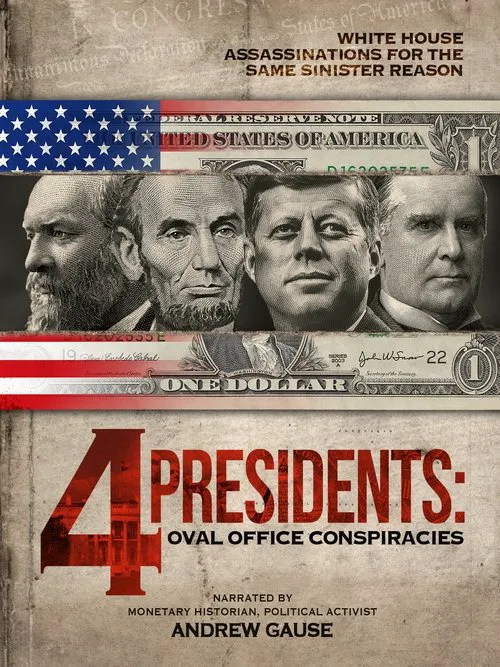4 Presidents

Plot
Four Presidents delves into an intriguing and chilling conspiracy theory that has garnered significant attention and debate among historians and conspiracy theorists alike. At its core, the documentary presents a compelling narrative that the deaths of four U.S. Presidents - Abraham Lincoln, James Garfield, William McKinley, and John F. Kennedy - are not mere coincidence, but rather connected to their bold decision to relinquish the nation's money-issuing power from private banks to the U.S. Treasury. The documentary begins its journey with the life and assassination of Abraham Lincoln, the 16th President of the United States. Lincoln's presidency was marked by several notable achievements, including the passage of the 13th Amendment, which abolished slavery, and his commitment to preserving the Union. However, one of his most significant accomplishments was taking control of the nation's money from the private banks and shifting it to the U.S. Treasury. The reasoning behind this decision was to prevent the banks from manipulating the nation's economy and to give the government greater control over its finances. As Lincoln continued to assert his authority over the nation's economy, he began to face opposition from various groups, including the Northern Banks and some members of his own cabinet. The documentary suggests that these groups saw Lincoln's decision as a threat to their power and wealth, and therefore, may have played a role in his assassination. On April 14, 1865, while attending a play at Ford's Theatre in Washington, D.C., Lincoln was shot and killed by John Wilkes Booth, a well-known actor and Confederate sympathizer. However, the documentary raises questions about the extent of Booth's motives and suggests that Lincoln's death may have been part of a larger conspiracy. The documentary then shifts its focus to the life and assassination of James Garfield, the 20th President of the United States. Garfield's presidency was short-lived, lasting just 200 days before his assassination on July 2, 1881. Like Lincoln, Garfield took steps to remove the nation's money-issuing control from private banks and transfer it to the U.S. Treasury. However, Garfield's decision was met with fierce resistance from the banking elite, who saw it as a threat to their power and wealth. The documentary suggests that Garfield's assassin, Charles J. Guiteau, may have been a pawn in a larger game to restore the banks' control over the nation's economy. The documentary also explores the life and assassination of William McKinley, the 25th President of the United States. McKinley's presidency was marked by several notable achievements, including the annexation of Hawaii and the establishment of the United States as a world power. However, McKinley's decision to take control of the nation's money from private banks and shift it to the U.S. Treasury was seen as a threat by the banking elite. McKinley was assassinated on September 14, 1901, while attending the Pan-American Exposition in Buffalo, New York. The documentary suggests that McKinley's assassin, Leon Frank Czolgosz, may have been a radical anarchist who was influenced by the banking elite's propaganda and disinformation. Finally, the documentary delves into the life and assassination of John F. Kennedy, the 35th President of the United States. Kennedy's presidency was marked by several notable achievements, including the establishment of the Peace Corps and the Alliance for Progress. However, Kennedy's decision to take control of the nation's money from private banks and shift it to the U.S. Treasury was seen as a threat by the banking elite. Kennedy was assassinated on November 22, 1963, while riding in an open-top car in a motorcade through Dealey Plaza in Dallas, Texas. The documentary raises questions about the official narrative of Kennedy's assassination, suggesting that there may have been a larger conspiracy to restore the banking elite's control over the nation's economy. Throughout the documentary, the filmmakers present a persuasive argument that the deaths of these four presidents are not mere coincidence, but rather connected to their decisions to relinquish the nation's money-issuing power from private banks to the U.S. Treasury. They argue that the banking elite, who stood to lose power and wealth if the presidents' decisions were implemented, may have played a role in their assassinations, and that the vice presidents who succeeded them quickly returned the money-issuing control back to the private banks. However, it is essential to note that the documentary does not present concrete evidence of a conspiracy, and the filmmakers' thesis is based on circumstantial evidence and interpretations of historical events. While the documentary raises intriguing questions and prompts further investigation, it also acknowledges that the truth about these events may never be fully known. In conclusion, Four Presidents presents a thought-provoking and chilling conspiracy theory that questions the official narratives of some of the most significant events in American history. The documentary prompts viewers to think critically about the role of power and wealth in shaping historical events and to consider the possibility that there may be more to the stories of these four presidents than meets the eye.
Reviews
Recommendations



